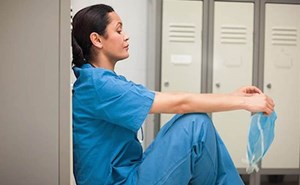
The Wedding
"You’re a doctor, right?" Somebody grabbed my husband’s arm, and he grabbed mine. The person had that look — the one any physician recognizes — the wild look of somebody terrified about an illness or accident. We broke into a run.
We were at a black-tie wedding in a remote area of Europe, and I was wearing 5-inch heels, indeed the tallest shoes I’ve ever worn. According to the manufacturer, each shoe weighed 1 pound. My gown was floor length and I grabbed great wads of material in my fists to keep the thing from snagging on foliage as we ran with the wild-eyed wedding guest.
Our sprint through the darkness (it was nearly 1:00 in the morning) took us along an escarpment which dropped down to a beach and lake. A staircase, enclosed on both sides, had been built into the slope of the mountain; an ornate door at its bottom allowed access to the lake. “He fell,” said our guide, and gestured into the darkness. I clomped down the stone steps in my enormous shoes and turned on the light from my cell phone. A man lay there, head crammed against the iron gate, legs extended up the slant of the stairs. Looking up, I could see where he’d fallen from: the top of a stone wall that separated the stairs from the escarpment, roughly 20 feet high.
My husband and I met in medical school. He is an orthopedic surgeon specializing in sports medicine, and I am a pediatric emergency doctor. We haven’t cared for the same patient since our trauma rotation in Baltimore 13 years ago, but somehow, we fell into a rhythm at the bottom of that pit. He stabilized the cervical spine and did a jaw thrust, I took the airway and circulation. Our patient’s face was swollen and bruised. His airway was open, with blood at the mouth and nose. His heart rate was 80, steady. He snored as if deeply asleep. Breath sounds? What a luxury a stethoscope would have been! Let alone a pulse oximeter, a bag valve mask, an IV cart, and a pair of gloves.
Equipment was not the only problem. A language barrier prevented clear communication with venue staff. Had they called an ambulance? (Yes.) Was there an AED on site? (No.) Unfortunately, the venue was practically inaccessible except by boat. Emergency workers would have to take an undulating one-lane road around the entire perimeter of the lake in the dark. Venue staff suggested an ETA of at least 40 minutes.
We eased our patient into recovery position, resting his head on his down arm and dinner jacket. Shortly thereafter, he began to vomit. Then his breathing became labored. His respiratory rate rose, his heart rate fell. I have never had to watch this happen. There is suction in my shop. When the patient vomits, I reach for the suction and clean it up. I thought of my bright and orderly resuscitation bay in New York City — it seemed like a dream of abundance and efficiency, impossibly far away.
We stayed calm and focused on the airway. What implement might provide suction and be located in any given banquet hall? A turkey baster. We shouted to the small crowd above us for a turkey baster, and lo and behold, a member of the kitchen staff raced down the stone steps and handed one to me 5 minutes later.
It was not an ideal tool. Turkey basters are made to siphon thin liquid, not the chunky bloody stuff of that night. But it was better than nothing. With my husband still on the cervical spine, I scissored his mouth open and suctioned.
Should we move him? He was in exactly the wrong physiologic position for care of a potential head injury: Trendelenburg (head low, feet high). But the great iron door blocking our egress to the beach only opened inward, and anyway, it was locked; the only way out was up the stairs. He was a large man; it would take several people to move him — and what about his spine? We might injure this stranger, make him worse.
This was the worst part, the waiting. In my day-to-day work, the 5 minutes until respiratory therapy arrives with a vent often feel like a millennium; now the minutes stretched ahead without end. Meanwhile, a small group of people had assembled along the wall above us, forming a sort of Greek chorus. “He is bleeding a lot!” shouted one person. “He cannot breathe!” shouted another.
“We know!” I shouted back, feeling edgy.
“Don’t get distracted,” said my husband. “It’s just us down here, okay?”
Is it possible to share an intimate moment in the bottom of a dark, bloody pit? As he held the man’s head and neck and I suctioned as best I could, we had a moment of silent appreciation for one another. It was comforting that we spoke the same language of ABC’s and shared a skill set that was buying time for this wedding guest. We knew we weren’t fixing all his problems, but we were buying time.
We are both often asked why we still practice medicine. The older we get, the more it happens. "You’re still doing that?" is the usual question. Many of our peers have moved on to nonclinical jobs, or other fields altogether. They tell their stories with giddy happiness. No more working weekends or holidays. No more of the system, the grind. In this conversation, the obvious corollary is that the joke is on us, still caught in the web of 21st century medicine. But there at the bottom of that pit, I felt pretty good about the choices I have made. I was proud of my field, of the skills I carry with me wherever I go. The ability to save a life, or even hold it steady for a while, carries worth; it is not a small thing.
Eventually, EMS arrived in a square white van and shooed us away. We emerged from the pit into the crew of spectators, collected our children, and slumped into the car that had been waiting over an hour to take us back to the hotel. There was blood under my nails and blood at the hem of my gown.
Our children eyed us with curiosity. They are used to our jobs, his calls, and my stories. Drama moves in and out of our lives, rocking the boat then leaving our little ecosystem peaceful again. “Did somebody die?” asked the 11-year-old.
“No.”
"Did you save them?"
“We just held onto them for a while.”
Satisfied, both kids fell asleep. The car carried us through the dark, over the ridges and slopes above the lake.
I think it's interesting that this happened at a wedding, a place where two people commit to one another and where guests have occasion to reflect on the decisions they’ve made in life, from who they married, to what career they chose, to where they decided to live and work. In a sense, I think that I “renewed my vows” to the emergency room. I’ve developed a new appreciation for the handy equipment that hangs on our walls, the needles and syringes in their orderly cart, the gurney that responds to a gesture of my sensibly shod foot by shifting into reverse Trendelenburg.
The next time I’m asked, "Are you still doing that?" I think I can say — despite the system and grind — that I will not give an apologetic shrug or roll my eyes, I know, I know, silly me. I will picture the sparse lights along that remote road, the way we passed from shadow to light and back, and the strange thrill I felt at having done something that mattered for another human being in that remote corner of our spinning planet. “Yes,” I will say. “I’m still doing this.”
Rachel Kowalsky, MD, MPH
Assistant Professor
Pediatrics and Emergency Medicine
Weill Cornell Medical Center



